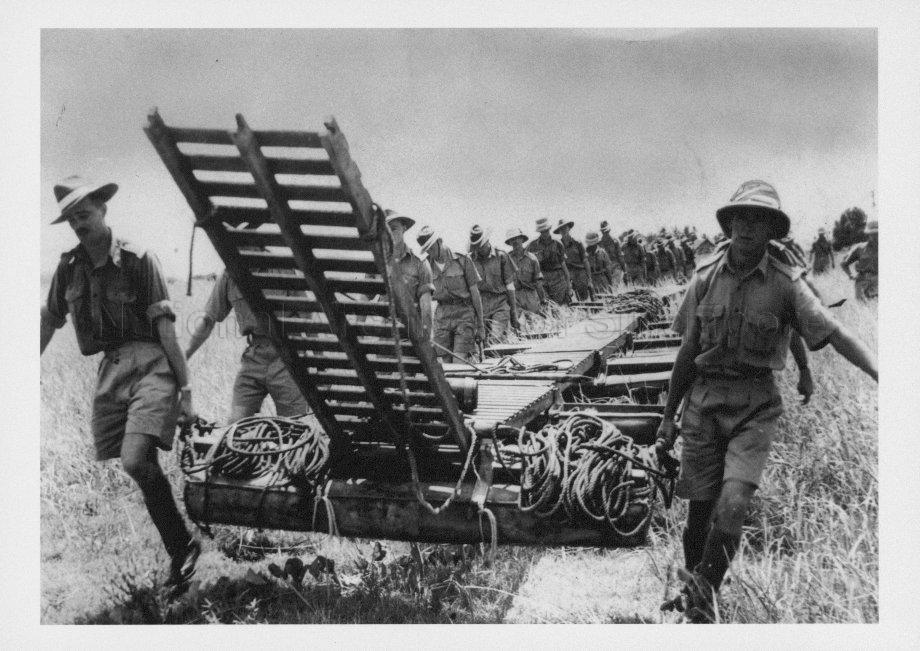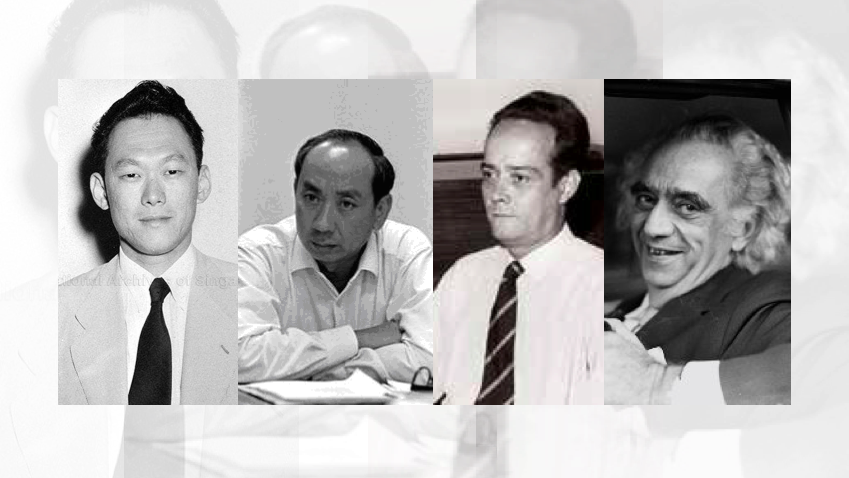February marks the anniversary of the Japanese invasion of Singapore (Feb. 8 to 15, 1942) and the beginning of the Japanese Occupation (1942 to 1945) -- the island nation’s darkest period in its history.
Prior to the Japanese invasion, Singapore had been subjected to relentless Japanese air raids from Dec. 8, 1941.
Many of S'pore's past leaders, such as Lee Kuan Yew and David Marshall, were young men when the bombs fell and battles began. They witnessed the destruction, lived through the uncertainties, and even got involved in the war effort.
Let's take a look at some of their experiences.
Lee Kuan Yew, Singapore's first prime minister (1959 to 1990)
Lee was an 18-year-old student at Raffles College (present day National University of Singapore) when the Japanese commenced their air raids on Singapore on Dec. 8 1941.
[caption id="" align="aligncenter" width="455"] Source: NAS[/caption]
Source: NAS[/caption]
Recording his wartime experience in his memoirs, The Singapore Story: Memoirs of Lee Kuan Yew, Lee said that he volunteered for the Medical Auxiliary Services (MAS) unit at Raffles College shortly after the air raids began, but the unit was disbanded on Feb. 12, 1942, three days before the fall of Singapore.
"Within days, the hostels were nearly empty. Lectures were suspended, and students asked to volunteer for a Raffles College unit of the Medical Auxiliary Service (MAS). I volunteered for the MAS, and cycled daily from my home (in Norfolk Road since 1935) to my post in the college three miles away. We were not provided with uniforms - there was no time for that - but we were each given a tin helmet and an armband with a red cross on it and paid a small allowance of about $60 a month, for which we worked on a roster round the clock. We were organised into units of six. There was no fear. Indeed there was barely suppressed excitement, the thrill of being at war and involved in real battles."
As the Japanese invasion of Singapore drew near, Lee observed that more Commonwealth soldiers from Malaya had retreated into Singapore. He also got a sense of the soldiers' morale through his short interaction with them.
"As I cycled home one morning, still wearing my tin helmet and armband, I passed a line of military lorries parked in Stevens Road. Standing beside them were some tall, very dejected-looking Australian soldiers wearing broad-brimmed Aussie hats. They looked frightened and demoralised. I stopped to ask them how close the front was. One soldier said, 'It's over; here, take this,' and offered me his weapons. I was startled and shaken. Could it be this hopeless? I refused the weapons and tried to comfort him by saying that no battle was lost until it was over. But for that Australian group, the battle was lost. I did not know what horrifying experiences they must have had."
[caption id="" align="aligncenter" width="920"] Australian troops in Singapore. Source: NAS[/caption]
Australian troops in Singapore. Source: NAS[/caption]
Goh Keng Swee, former Deputy Prime Minister (1973 to 1984) and first-generation cabinet minister
When war broke out, Goh, 23, a tax collector under the colonial War Tax Department, joined the Straits Settlements Volunteer Force (SSVF) in early February 1942. He was assigned to the Force's Signals company.
[caption id="" align="aligncenter" width="342"] Source: Jurong GRC [/caption]
Source: Jurong GRC [/caption]
In the book, Goh Keng Swee: A Portrait by Tan Siok Sun, Tan notes:
[Goh] had earlier in the month joined the Straits Settlements Volunteer Force (SSVF), due partly to his father's persuasion, and partly to his desire to do something in addition to his day job with the War Tax Department. Cleaver Rowell Eber, who joined the SSVF in 1930, remembered [Goh] as being a lance corporal from D Company - a Singapore Fortress Signals Company which consisted mainly of civil servants and City Council employees.
On Goh's duties as a volunteer signaller, Tan recorded that Goh was stationed at the Battle Box at Fort Canning, where Lieutenant-General Arthur Percival would later make the fateful decision to surrender to the Japanese.
[Goh's] specific duties had been to man the Battle Box at Fort Canning, and this included the receiving and sending of coded messages. He would spend eight hours on duty before being allowed the next 16 hours off. He also had to undergo a rotation shift whereby he went underground for a number of hours before returning above ground to carry out sentry duties.
Being stationed at the Battle Box, Goh was able to witness the destruction inflicted by Japanese air raids on Singapore.
In the evening of Monday, 9 February... [Goh] was on sentry duty on the top of Fort Canning and had a "grandstand view" of the Japanese aerial bombardment of the island. He remembered vividly with awe how the whole of Singapore was ablaze with lights; Japanese bombers were flying in perfect V-formation, evading with ease the British searchlights criss-crossing into the night and the resultant anti-aircraft fire. From his vantage point, he could also see the explosion of light each time a Japanese bomb found its target, and the occasional fireball whenever a Japanese bomber was shot down.
[caption id="" align="aligncenter" width="650"]
Source[/caption]
Edmund William Barker, Singapore's first and longest-serving law minister (1964 to 1988)
Barker was 21 years old when the war came to Singapore. He was a volunteer with the SSVF.
[caption id="" align="aligncenter" width="220"] Source: Serangoon Sec[/caption]
Source: Serangoon Sec[/caption]
In E W Barker: The People's Minister, Barker was said to have helped the British inspect bombsites to retrieve bodies and help casualties. He also joined the colonial health department.
When the bombs began falling on Singapore, several of Barker's friends at Raffles College - including Lee Kuan Yew and Maurice Baker - volunteered for the auxiliary medical unit. Barker volunteered to inspect bombsites to help the injured and retrieve bodies. He also joined the health department's anti-malarial unit. H had nothing to do, he said of his decision, so after packing his books, he signed up for a course in dealing with malaria ended up working as a sanitary inspector.
David Marshall, the first Chief Minister (1955 to 1956) of a self-governing Singapore under the British and founder of the Workers' Party in November 1957
Marshall was 38 when Japanese planes began bombing Singapore in December 1941.
He, too, volunteered with the SSVF and was mobilised in the lead up to the Japanese invasion of Singapore.
[caption id="" align="aligncenter" width="384"] Source: NAS[/caption]
Source: NAS[/caption]
According to Marshall of Singapore: A Biography by Kevin Tan, Marshall was mobilised and assigned to B Company, under the 1st Singapore Battalion, which was initially assigned to defend the southern coast of Singapore.
Once the volunteers had been processed and kitted up, they collected the company's general stores before being transported to Geylang English School, requisitioned for use as headquarters for the 1st Singapore Battalion, which comprised A, B, C and D companies. The 1st Battalion had been assigned to defend the beaches on the southern side of Singapore island, from Bedok to just past the Singapore Swimming Club at Tanjong Rhu. The defence of the stretch of shore from Bedok eastwards to Changi was in the hands of the Manchester Regiment.
Later, Marshall's unit was moved northwards, as the Japanese invasion was coming from the north. Under somewhat bizarre circumstances, Marshall's B Company found itself caught in action.
B Company was stationed out on the southeast coast of Singapore from December 1941 to early February 1942. When it became quite clear that the Japanese were not going to land on Singapore's southern beaches, the high command decided to move the SSVF troops northwards to halt the Japanese attacks. On 11 February, 1942, B Company was moved to Pierce Road, in the middle of the island, to reinforce an Australian battalion. The reality of war had not sunk in with many of the officers and men who bore the responsibility of defending Singapore. Indeed, when B Company reached their Pierce Road destination, one of their officers told SSVF troops they should not have driven up Holland Road as it was under fire. To the consternation of all, the troops were actually told to get back on the lorry and repeat the operation, just as if they had fouled up during training! This time round, the troops were truly under fire and now had to inch their way to their destination. After a long while, they managed to get to a tennis court. It was a frightening experience for the volunteers, who had never experienced anything close to this, not even in the most realistic of simulated battles. They were dodging mortars and enemy fire and staring mortality in the face.
Amidst that chaos, Marshall demonstrated his bravery in a strange way, as recalled by Bill Goode, who had served in the same company as Marshall:
Mortars were going off all round us and we were very frightened. At least I was. We were suddenly revived, in the midst of all that mortaring, by the appearance of David Marshall who came walking up the drive with a bucket of tea! How he had the courage to be walking around with a bucket of tea under those unpleasant circumstances, I don't know! But it was a most encouraging sight. In peace-time soldiering, ...he was not a very smart soldier... But there was absolutely no doubt at all, when it came to being under fire, that you realised what a tremendously brave man David Marshall was.
This incident resulted in the company commander making Marshall the company runner for the rest of the Battle of Singapore, which was to last till February 15, 1942, when the British surrendered to Japanese forces.
Correction: An earlier version of the article had mentioned that the Japanese air raids on Singapore commenced on Dec. 8, 1942. This is incorrect. The correct date of the start of the Japanese air raids on Singapore is Dec. 8, 1941. This article has been updated to reflect the correction.
Top image from here, here, here, and here.
If you like what you read, follow us on Facebook and Twitter to get the latest updates.
If you like what you read, follow us on Facebook, Instagram, Twitter and Telegram to get the latest updates.
